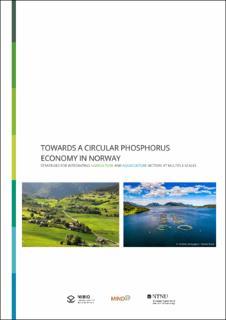| dc.description.abstract | Phosphorus is a building block for all life and therefore plays an essential role in food production. Currently, large amounts of phosphorus enter the Norwegian food system from abroad in the form of mineral fertilizer, feedstuff, food, as well as micro-ingredients for animal feed, mainly in salmon farming. However, only a small fraction of this phosphorus ends up as food for humans, while the largest part accumulates in soil and water systems. This inefficiency entails two challenges: 1. Phosphorus supply is critical. Phosphate rock, the primary source of phosphorus for fertilizer and micro-ingredient production, is a limited resource that is highly concentrated in a few countries. Over 80% of global phosphate rock reserves are found in only 5 countries, and ~70% are located in Morocco and Morocco-occupied Western Sahara. The high concentration renders many countries vulnerable to geopolitical and economic instabilities and threatens food safety. The EU has therefore included phosphate rock on its list of Critical Raw Materials. 2. The accumulation of phosphorus in water systems can lead to eutrophication and dead zones, threatening fish stocks and other aquatic life. The high phosphorus concentration in soils due to overfertilization over long periods of time increases the danger of losses to water systems by runoff, further exacerbating the eutrophication risk. A more circular use of phosphorus could simultaneously reduce supply and pollution risks. This is particularly relevant in Norway, where the government has an ambition to increase salmon and trout production from currently 1,5 to 5 million tons by 2050. Achieving a circular phosphorus economy is a complex task: (i) The land- and the sea-based food systems are increasingly interlinked, for example through agricultural production of fish feed or the application of fish sludge on agricultural land. (ii) The Norwegian phosphorus cycle is increasingly interlinked with that of other countries as trade flows along the entire food supply chain are growing. (iii) Phosphorus fertilizers, both primary and recycled, are often contaminated with heavy metals such as cadmium, uranium, and zinc, which tend to accumulate in soils. Cleaning the phosphorus cycle is therefore vital for soil fertility and human health. This report is based on the MIND-P project, which studied the Norwegian phosphorus cycle for both agriculture and aquaculture at a farm-by-farm basis and explored options for increasing circularity. The project identified farm-level and structural barriers to managing phosphorus resources more effectively. We propose four fundamental strategies to overcome these barriers: 1. Develop and maintain a national nutrient accounting. 2. Minimize phosphorus losses and accumulations at farm level. 3. Establish infrastructures for capturing, processing, trade, and use of manure and fish sludge to produce high-quality recycled fertilizers that are tailored to the needs of the users in Norway and abroad. 4. Adopt a regulatory framework to promote a market for recycled fertilizer. The strategies proposed here were developed with the support of an Advisory Panel consisting of representatives from government, industry, industry associations, and NGOs in an online and two physical workshops conducted in 2022. | en_US |

